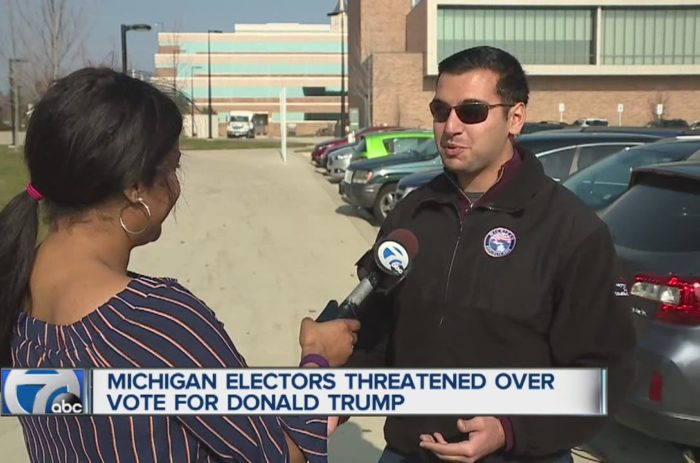
The following is an excerpt from OpinionJournal’s “Best of the Web” at The Wall Street Journal written by the editor, James Taranto.
Vegetarian Zookeeper Bites Rhinoceros—Now That Would Be News
“Rhino, Though Vegetarian, Bites Lincoln Park Zoo Keeper’s Finger”—headline, Chicago Sun-Times website, April 16
Breaking News From Genesis 1:2-3
“The Water in Your Glass Might Be Older Than the Sun”—headline, New York Times, April 16
New York Values Trump
“So someone said New York values are horrible and then New Yorkers voted overwhelmingly for Hillary and Trump?” quipped Frank Fleming on Twitter last night. Ouch. We say that on behalf of all New Yorkers.
Yesterday’s victory was a milestone for Donald Trump—his first popular-vote majority in a state primary or caucus. That was generally understood to be likely, if not quite a sure thing. But Trump didn’t just exceed 50%, he came very close to, and may top, 60% statewide, outpolling his rivals in every county but one (New York—i.e., Manhattan) and every congressional district but one (the 12th, which includes Manhattan’s east side). John Kasich beat him narrowly in both Manhattan and the 12th District.
The popular-vote majority is significant because New York has a 50% winner-take-all delegate-allotment threshold, both statewide and in congressional districts. Our reading of the Associated Press results gives Trump 89 delegates to four for Kasich, with two still outstanding in districts where Trump is on the cusp of 50% with a few precincts uncounted. Trump is a hair’s breadth above 50% in one and below in the other, so let’s call it 90-5. Ted Cruz finished a distant third and leaves the Empire State without a single delegate.
Yet the overall nomination picture hasn’t changed much since yesterday. As Henry Olsen observed for National Review before the polls closed last night: “Two weeks after Ted Cruz’s unexpectedly large victory in Wisconsin, New York Republicans look poised to deliver exactly the same blowout in favor of Manhattan’s own Donald Trump as they were before the Badger State supposedly changed the race.” Olsen offered these predictions:
I think it likely that Trump wins between 51 and 56 percent of the vote, with Kasich taking between 20 and 25 percent and Cruz between 18 and 25 percent. My best guess is Trump 54, Kasich 24, Cruz 20.
Winning 54 percent should give Trump majorities of the vote in between 17 and 22 CDs. My best guess is he will get all three delegates in 19 CDs. He should win all the others, giving him two delegates each.
Kasich should finish second in six of those seats, giving him six delegates. Cruz will finish second in two, giving him two delegates. The delegate totals should be Trump 87, Kasich 6, Cruz 2.
The actual totals, with 98.8% of precincts reporting: Trump 59.8%, Kasich 24.7%, Cruz 14.4%. Trump won all three delegates in at least 22 and possibly as many as 24 districts, and Kasich managed a 2-1 split in at least one, maybe two or three. Olsen slightly underestimated Trump and overestimated Cruz and very slightly underestimated Kasich—but the net difference is no more than four delegates.
As Olsen observes, “there is no such thing as momentum.” The Trump campaign, understandably, is arguing otherwise. “Ted Cruz is mathematically out of winning the race,” Trump himself tweeted this morning. “Now all he can do is be a spoiler, never a nice thing to do. I will beat Hillary!”
By “winning the race,” Trump means securing a majority of delegates, 1,237, before the July convention. By “be a spoiler,” he means prevent Trump from securing a majority of bound delegates, thereby forcing a second ballot unless Trump can win over enough unbound delegates to reach the 1,237 threshold. The AP confirms Trump is right: Cruz is now mathematically eliminated from a preconvention win. But it has been clear for weeks that was inevitable, either this week or next, when five more Northeastern states—Connecticut, Delaware, Maryland, Pennsylvania and Rhode Island—vote in primaries.
Trump is making a belated effort to win over party insiders, Bloomberg reports:
Even as Donald Trump rails against the “rigged” presidential nominating process, his team is playing nice with the party officials who make up the core of that system.
On Tuesday, Team Trump invited 168 members of the Republican National Committee to come to a campaign presentation Thursday night. The reception appeared on an official RNC schedule that went out to members Tuesday night. . . .
Some of the candidate’s chief strategists, including Paul Manafort, will be on hand to mingle with the party leaders at the Thursday night reception and to share a formal presentation spelling out Trump’s path to victory.
The University of Virginia’s Kyle Kondik and Geoffrey Skelley look at the primaries ahead and conclude that Trump’s path to 1,237 is “challenging but possible.” They list five necessary conditions, including a May 3 victory in Indiana—which, in lieu of any polling, Kondik and Skelley analyze as follows:
We think Indiana is fairly similar to Missouri, a Midwestern state with a southern orientation. Missouri also happened to be the closest primary in this year’s race: Trump won statewide by about 0.2 percentage points as both he and Cruz got about 40% of the vote. Cruz will almost certainly have to clear 40% to beat Trump in Indiana, and he very well could.
Then again, Indiana abuts Ohio, so it’s possible Kasich could end up giving Trump a boost by acting as a “spoiler” for Cruz.
On the Democratic side, your humble columnist more or less predicted the outcome yesterday: a big victory for inevitable nominee Hillary Clinton over Bernie Sanders. Her margin is 58% to 42%, very close to her performance in February 2008, when she beat Barack Obama 57% to 40% (with several other candidates splitting the change).
But whereas in 2008 Mrs. Clinton won every county in the state save Tompkins (Ithaca), this time her victory was more geographically concentrated. She beat Sanders in New York City and five suburban counties (including Westchester, where she officially resides). But he won every county upstate except three large urban ones: Erie (Buffalo), Monroe (Rochester) and Onondaga (Syracuse).
A comparison of exit polls then and now shows the difference through a demographic filter. Mrs. Clinton outpolled Obama, 59% to 37%, among white New York Democrats, but tied with Sanders. She lost to Obama among blacks, 61% to 37%, but easily bested Sanders, 75% to 25%. Among Latinos, she topped both Obama (73% to 26%) and Sanders (64% to 36%). In sum, she lost ground among nonblack Democrats but made up for it among blacks.
The exit-poll sample this year was 22% black, vs. 16% in 2008. The white proportion dropped to 59% from 70%. Similar numbers of Democrats voted in both year’s primaries (1.86 million in 2008, 1.81 million counted so far this year), which means, interestingly, that if the exit-poll samples were accurate, black turnout was up by some 100,000 over the primary featuring the man who became the first black president.
In a New York Post New York postmortem, John Podhoretz advises readers: “Resign Yourself to the Depressing Reality: It’s Going to Be Trump vs. Clinton.” As noted above, there’s still some question about Trump. As for Mrs. Clinton, resignation is probably in order, although her rival’s campaign isn’t ready to follow Podhoretz’s advice.
Talking Points Memo notes that Sanders campaign manager Jeff Weaver told MSNBC: “We’re going to go to the convention”:
“It is extremely unlikely that either candidate will have the requisite number of pledged delegates to get to this number,” he added. “So it is going to be an election determined by the superdelegates.”
The superdelegates—party and elected officials—are overwhelmingly with Mrs. Clinton. They’re free to change their votes, but it’s not clear why they would. Maybe the Sanders camp is holding out for a law-enforcement deus ex machina.
Meanwhile, the Huffington Post’s Howard Fineman summed up the primary yesterday afternoon: “The Real New York Results Are Already In—and the Winner Is Nastiness.” Ted Cruz isn’t the only one who looks askance at New York values.
For more “Best of the Web” from The Wall Street Journal’s James Taranto click here.



